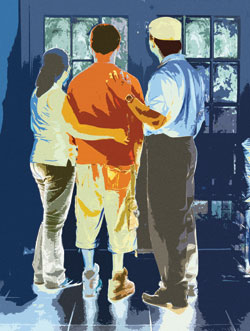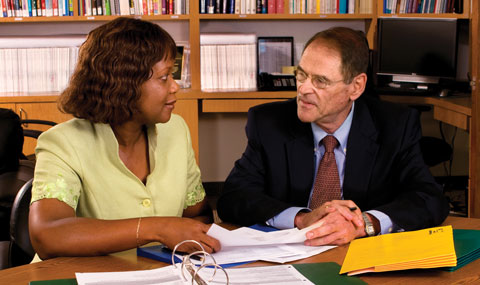Reclaiming the Child, Reconnecting the Family
By Dwayne Campbell | Photos by John Zillioux
Brief Strategic Family Therapy, a highly effective and practical short-term intervention to improve youth behavior that was pioneered at the Miller School, enables families to rediscover the love obscured by hurt.
 |
| Brief Strategic Family Therapy restored a nurturing relationship among Amanda, Roberto, and Nelson. |
For months on end, Roberto’s bedroom was a place of refuge. In his family’s small apartment, his room was where he could watch TV, talk on the phone with his girlfriend, and send text messages without risking an argument with his dad. In this safe haven, father and son would not cross paths.
To make matters worse, the once close relationship with his mother was under strain. She seemed to be always complaining—about his grades, about his staying out too late with the wrong crowd, about his “attitude” that seemed to be abandoning strong Nicaraguan values for Miami laissez faire. At times she wondered if he was involved with drugs.
But after a while, living like a prisoner with privileges was becoming too much for an outgoing boy who saw himself as a typical teen—no different from the majority of kids in his neighborhood who dressed with a cool urban edge and communicated effortlessly in two languages. He also never used drugs, but spent his free time promoting teenage dances.
“My mom wasn’t trusting me anymore. She believed she was always right,” recalls Roberto.
“My dad has a really strong personality and I have a really strong personality, so we would always bump heads. To prevent that we just wouldn’t talk,” he says, pausing to choke back tears from the vivid memories. “It shouldn’t have been that way.”
As the disagreements with his mother, Amanda, grew louder and the relationship with his father, Nelson, more silent, Roberto, then 16, suggested the family seek therapy, something he had experienced about five years earlier when his grandmother’s death was too much to bear.
“At that point I was going through a lot, and some of that therapy was helpful,” says Roberto, who had spent summers in Nicaragua with his grandmother and had grown very close to her. “It didn’t solve all our problems, but I was thinking we should give it another try.”
It was several weeks before Amanda took her son seriously and called Regis House, a community-based nonprofit organization that provides family support and various counseling services for children. And it so happened that at Regis House, two therapists were recently trained and certified in Brief Strategic Family Therapy (BSFT) by the Miller School of Medicine. Based on the prescreening results, the therapist thought BSFT could help the troubled family.
 |
| Joan A. Muir, Ph.D., and José Szapocznik, Ph.D., lead the training institute that is spreading the use of Brief Strategic Family Therapy. |
BSFT is an intervention used to treat adolescents with problem behaviors, including family conflict, association with anti-social peers, and delinquency.
It is especially useful for adolescents with problem behavior and drug abuse.
Administered by the BSFT Training Institute of the University of Miami Center for Family Studies, BSFT has gained national and worldwide attention and since 2002 has been endorsed by the United States Department of Justice, Office of Juvenile Justice and Delinquency Prevention as an “outstanding therapy model” and by the National Institute on Drug Abuse in its Therapy Manuals for Drug Addiction.
BSFT was pioneered at the University of Miami over three decades ago by José Szapocznik, Ph.D., now professor and chair of epidemiology and public health, based on surveys used to gauge the orientation of Cuban immigrants in Miami. Research showed that cultural conflicts were significant and while parents were attempting to hold on to hierarchical dominance and old-country ways, their children were adapting quickly to the language, lifestyle, and, sometimes, the vices of the new country.
“A lot of these kids were using club drugs, and there was significant intergenerational conflict that had a cultural flavor—parents were staying in one culture and the kids were growing up in another,” says Szapocznik, who led the UM study that looked at the cultural values of the Cuban adolescents and what intervention might best serve them.
Szapocznik, who is also director of the BSFT Training Institute, says the early research showed “many of the values of the Cuban population were those of families in crisis, similar to what you’d find in poor families in distressed communities in this country.”
What became clear to the researchers was that even when a child was exhibiting serious behavior problems, the “familial” bonds were such that immediate family members or guardians retained their importance and
had the potential to positively affect the outcome when included in the therapy process.
This became the basis of BSFT, which operates on the belief that family members are interdependent and parents generally have the child’s best interest at heart. Using well-known therapist Salvador Minuchin’s structural family therapy as a platform, BSFT began taking shape and standing apart because of its program of research that adopted existing therapies to be used with families from diverse cultures.
Under Szapocznik’s leadership, BSFT has become a widely respected evidence-based practice (UM faculty introduced BSFT at a conference in Sweden last September) and attracted funding from the National Institute on Drug Abuse. The federal agency has supported three major studies focusing on the difficult task of getting whole families, including rebellious teens, into treatment. The studies and tests show that Hispanic and African-American families benefit immensely from BSFT because of the strong family bonds in both ethnic groups.
On a September evening in 2007, Amanda and Roberto made their first visit to Regis House. That’s when they met therapist Luisa Ramirez, M.S.W., who would employ her BSFT skills to help strengthen the family.
But there was a snag. BSFT requires that all family members central to an adolescent’s life be involved in the therapy, which, depending on progress, could last anywhere from 12 to 16 weeks. Nelson, Amanda insisted, would not take part.
But for Ramirez to observe the family’s “patterns
of interaction,” an integral part of BSFT, she first had to “engage” them—including Nelson. Ramirez got past Amanda’s hesitation and secured her permission to
call Nelson.
“I wasn’t sure about doing any of this, but she convinced me I should be a part of it, that I should
do it for my son,” Nelson says.
“You really have to engage each and every one
of the family members, and that’s something we’re passionate about in BSFT,” explains the BSFT Institute’s Maria Tapia, LCSW, who helped train Ramirez.
“BSFT can happen fairly quickly, but it works because it is so strategic,” Tapia adds. “For example, Luisa had to validate the mother before Amanda would feel comfortable having Luisa reach out to the father. The whole idea is to change the family’s repetitive patterns of interactions that get them into trouble.”
At home, Nelson displayed his frustration over
a lack of consistent work and a son he thought was disrespectful, and Amanda worked long hours and came home to a house of tension.
“There was so much going on at home, and it
felt like I was being blamed,” says Roberto, now 18.
As they went through BSFT the family discov-ered much about itself.
“I was kind of upset when we started, but as it went along I started to understand,” says Nelson. “I realized that there were many things interrupting our father-son relationship. There were money issues, and I found out that conflict in the relationship between my wife and I prevented us from giving him the attention he needed.”
“Money was influencing how we were as a family, but Nelson didn’t understand that until we started therapy,” Amanda says. “There was poor communica-tion between us, and that affected our son. So much about how we affected him came out [in therapy].”
Though BSFT normally delivers very timely results, Ramirez wasn’t expecting what she called
a “breakthrough moment” in the third session.
“We reached a moment that seemed like it was created for us,” says Nelson. “My son and I embraced. We hugged, we cried. I saw very clearly that regardless of what was happening, all he wanted was for us to be a family.”
Amanda was also overcome by the memory.
“It was that moment we realized a lot of things about ourselves as a couple, things we didn’t think he knew,” says Amanda. “That made me feel really bad. But this was a time to look at all the bad things that were happening and let it all out. For the first time
in a long while I really listened to my son.”
Though it was months later, the discussion reopened the emotional gates. “This one session was special,” says Roberto. “I remember how we hugged. I remember how we cried.”
Essentially, with the family involved, BSFT shifts family members from the conventional notion of “fixing the problem child” to changing the way family members behave with each other—helping them to find the love hidden behind the hurt. Included in that, in Roberto’s case, is “detriangulation,” a process that extracts the child from the problems of the couple.
“BSFT changes the relationship to what we’re hoping will lead to protecting the kids inside and outside the family,” says Joan A. Muir, Ph.D., associate director of the BSFT Training Institute at the Miller School. “At the same time, we are not blaming the parents; we help them behave differently in the family to restore them to parental roles.
“We are not trying to tell parents what to do, we are leaving them healthier with the idea that they will
be able to solve the problems their kids have, whether they were abused, have learning problems, are in need
of medication. … We don’t prescribe those things. We prescribe getting a healthier family so the family solves those problems. That’s why it’s revolutionary.”
The Miller School is now working on spreading that revolution, albeit with caution to ensure fidelity
to the model. Through the Center for Family Studies, the BSFT Training Institute has embarked on training community therapists locally, nationally, and some abroad, in a process that takes six to eight months.
“Families have problems, but that’s not how they want it to be,” says Ramirez. “BSFT works because even though parents come in to save their child, we are using a model designed to save the family. I remember Nelson saying to me, ‘Thank you for giving my son back to me.’ I said, ‘You took your son back.’”
For Roberto, his house is a home again.
“Before therapy, I would lock myself in my room just to prevent any arguments,” Roberto says. “Now the vibe is different. We are interacting more. We are talking more. There’s life in the house.”
|


